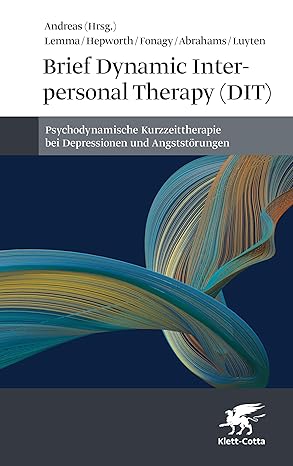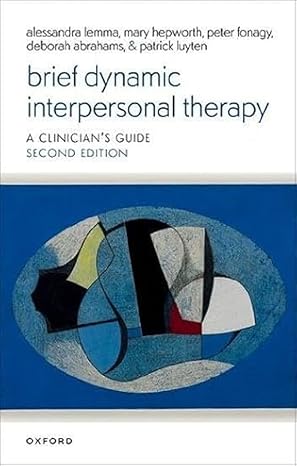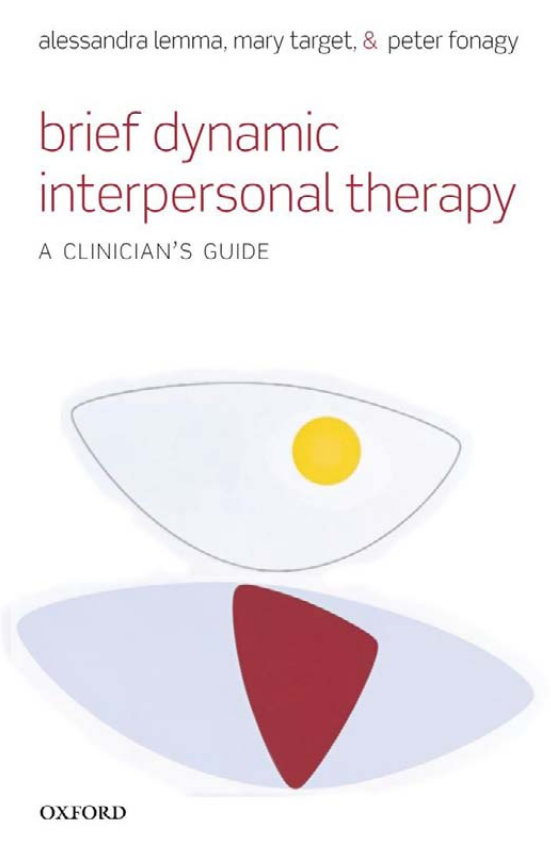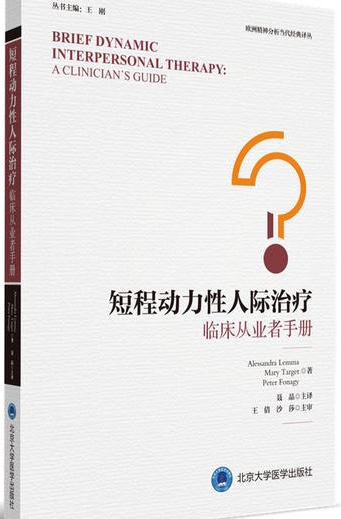封面
Alessandra Lemma, Mary Target, Peter Fonagy - Brief Dynamic Interpersonal Therapy_ A Clinician's Guide -Oxford University Press, USA (2011)
Hanna Levenson, Stephen F. Butler, Theodore A. Powers, Bernard D. Beitman - Concise Guide to Brief Dynamic and Interpersonal Therapy, 2nd edition (Concise Guides) (2002)
2025
2024
2011
Brief Dynamic Interpersonal Therapy 2e
作者: Prof Alessandra Lemma / Prof Mary Hepworth / Prof Peter Fonagy 出版年: 2024-7 页数: 424 ISBN: 9780198867470
Brief Dynamic Interpersonal Therapy
作者: Lemma, Alessandra; Target, Mary; Fonagy, Peter 出版年: 2011-9 页数: 288 定价: $ 45.14 ISBN: 9780199602452
内容简介 · · · · · · Dynamic Interpersonal Therapy (DIT) is a brief psychodynamic psychotherapy developed for the treatment of mood disorders. It is being rolled out as part of the Improving Access to Psychological Therapies (IAPT) initiative as the psychodynamic model for the treatment of depression. This book is a user-friendly, practical guide for the implementation of a brief psychodynamic intervention in routine clinical practice as well as in research protocols. It sets out clearly the theoretical framework, as well as the rationale and strategies for applying DIT with patients presenting with mood disorders (depression and anxiety). Throughout, it is illustrated with detailed examples that help the reader to implement the approach in their practice. The book will be required reading to support the national IAPT training initiative, as well as providing a resource for mental health professionals specialising in psychodynamic psychotherapy and wishing to work within a limited time frame.
非常细了,一个一个步骤都列了出来;撇开细节,理论框架上我更喜欢CCRT
简评短程动力性人际治疗—临床从业者手册 终于碰到了一本简明易懂、丰富具体,没有那种“看不懂是你智商不够”自恋味道的精神分析专业书。
终于碰到了一本简明易懂、丰富具体,没有那种“看不懂是你智商不够”自恋味道的精神分析专业书。 该书由三名顶级专家合著,并由国内不超过5名拥有IPA(国际精神分析协会)分析师资质的王倩老师邀请其好友—北大心理中心专职心理咨询师聂晶老师翻译,本书英文版已于2011年由英国牛津大学出版社出版,中文版2018年3月才出版,共十一个章节,24.7万字,具体描述了设置为16次的精神分析治疗,每次治疗(咨询)的结构和要点。
对于那些希望在日常工作实践当中,使用具有实证基础的动力性技术的临床医生或心理治疗(咨询)师而言,这本《短程动力性人际治疗——临床从业者手册》是必不可少的读物。
Dynamic Interpersonal Therapy (DIT) is a brief psychodynamic psychotherapy developed for the treatment of mood disorders. It is now offered in the UK in NHS for the treatment of depression and has been applied worldwide in public health care settings as well as private settings.
This book is a user-friendly, practical guide for the implementation of a brief psychodynamic intervention in routine clinical practice as well as in research protocols. It has been substantially updated since the first edition in 2011 with the addition of 5 new chapters to reflect new applications of the model in complex care, for patients with functional and somatic disorders and for internet delivered DIT and it outlines the changes in the training of DIT practitioners . It sets out clearly the theoretical framework, as well as the rationale and strategies for applying DIT with patients presenting with mood disorders (depression and anxiety). Throughout, it is illustrated with detailed examples that help the reader to implement the approach in their practice.
The book will be required reading to support training initiatives in DIT, as well as providing a resource for mental health professionals specialising in psychodynamic psychotherapy and wishing to work within a limited time frame.
作者简介
Alessandra Lemma, Fellow, British Psychoanalytic Society,Mary Hepworth, Professor of Psychoanalysis, University College London,Peter Fonagy, Fellow, British Psychoanalytic Society,Patrick Luyten, Professor, University of Leuven,Deborah Abrahams, Psychoanalyst (M. Inst. Psychoanal.), Clinical Psychologist (HCPC) and Programme Director of DIT, Anna Freud Centre
Alessandra Lemma is a Fellow of the British Psychoanalytical Society and Consultant at the Anna Freud National Centre for Children and Families. She is Visiting Professor, Psychoanalysis Unit, University College London and is Visiting Professor, Istituto Winnicot, Rome. For many years she worked at the Tavistock Clinic where she was, at different points, Head of Psychology and Professor of Psychological Therapies. She was the Editor of the New Library of Psychoanalysis book series (Routledge) for ten years until 2020 and was one of the regional Editors for the International Journal of Psychoanalysis until 2018. She has published on psychoanalysis, the body, trauma, the impact of digital technologies and ethics.
Peter Fonagy, OBE, Professor of Contemporary Psychoanalysis and Developmental Science, Head of Division for Psychology and Language Sciences, UCL; Chief Executive of the Anna Freud National Centre for Children and Families and Executive Clinical Director, UCLPartners Mental Health and Wellbeing Programme. His clinical and research interests lie in early attachment relationships, social cognition, borderline personality disorder and violence. A central focus has been an innovative research-based psychodynamic therapeutic approach, mentalization-based treatment, which was developed in collaboration with a number of clinical sites in the UK and USA. Publishing over 630 scientific papers and 21 books.
Deborah Abrahams is a psychoanalyst and clinical psychologist practising in North West London. She is currently the Programme Director of DIT at the Anna Freud Centre and involved in developing, delivering and evaluating the 20-Day DIT training. She co-wrote A Clinical Guide to Psychodynamic Psychotherapy (Routledge, 2021).
Mary Hepworth is a Professor of Psychoanalysis at University Collge London. After training in clinical psychology at Oxford, she worked in public health settings for ten years, and trained as a psychoanalyst. Her academic career has been at University College London (UCL), teaching psychology and psychoanalytic theory, and researching in adult and child attachment, treatment outcomes across therapies, and the blending of quantitative and qualitative research methods, especially analysis of interview narratives. She also worked for several years at the Anna Freud Centre which is affiliated with UCL and hosted some of the research and treatment developments, including DIT; she served as Professional Director there 2003-13. In parallel, she has also maintained a clinical practice in psychotherapy and psychoanalysis.
Patrick Luyten, PhD is Professor of Clinical Psychology at the Faculty of Psychology and Educational Sciences, University of Leuven (Belgium) and Professor of Psychodynamic Psychology at the Research Department of Clinical, Educational, and Health Psychology, University College London (UK). His main research interests are disorders from the affective spectrum (i.e., depression and stress- and pain-related disorders), and personality disorders. In both areas he is involved in basic research and in interventional research.
短程动力性人际治疗
作者: Alessandra Lemma 出版社: 北京大学医学出版社 副标题: 临床从业者手册 原作名: Brief Dynamic Interpersonal Therapy: A Clinical Guide 译者: 聂晶 出版年: 2018-3 页数: 259 定价: 48 装帧: 平装 ISBN: 9787565917462
内容简介 · · · · · · 《短程动力性人际治疗——临床从业者手册》是针对短程动力人际治疗的临床指导手册,书中详细介绍了短程动力人际治疗(DIT)的概念,及其相关理论基础和框架,以及DIT的具体操作过程。DIT的出现,主要是出于实用性的原因,为了能够让那些接受过动力性心理治疗或者咨询培训的临床工作者,可以较为轻松地获得一些具体策略和技能,施展在有时间限制的、针对抑郁和/或焦虑障碍患者的治疗工作当中。
《简明动态人际治疗:临床指南》详细目录
目录
-
导论
- 概述
- 历史背景
- 理论基础
-
治疗框架
- 治疗目标 (pp. 97-8)
- 治疗设置 (p. 101)
- 治疗阶段
- 初始阶段 (pp. 64, 65, 77-104)
- 目标 (pp. 97-8)
- 谨慎故事 (pp. 80-2)
- 患者参与 (pp. 77-9)
- 框架 (pp. 100-1)
- 信息收集 (pp. 82-96)
- 信息提供 (pp. 98-100)
- 风险管理与自伤 (p. 100)
- 关系数量 (pp. 96-7)
- 结果监测 (pp. 101-2, 103)
- 治疗内容 (pp. 97-8)
- 中间阶段 (pp. 138-41)
- 结束阶段 (pp. 214-15)
- 初始阶段 (pp. 64, 65, 77-104)
-
治疗技术
- 澄清 (pp. 79, 150, 151-3)
- 解释 (pp. 150, 153-7, 172-4)
- 内容 (p. 156)
- 有用解释 (pp. 155-8)
- 过程 (pp. 154-5, 156)
- 对抗 (pp. 150-1, 158)
- 协作工作 (pp. 75, 79, 122, 156, 208)
- 沟通分析 (pp. 165-6)
- 家庭作业 (pp. 166, 167)
- 反移情 (pp. 26, 31-2, 118-20, 184-5, 221)
- 移情 (p. 141)
- 个案构建 (pp. 75, 105-6)
- 步骤指南 (pp. 111-15)
- 组件 (pp. 111-12)
- 所需信息 (pp. 82-96)
- 利用移情和反移情 (pp. 118-20)
- 患者信息手册 (pp. 231-5)
- 会话评分表 (pp. 237-9)
-
心理动力学概念
- 依附理论
- 安全依附 (pp. 84, 93)
- 不安全依附 (pp. 40, 53, 84-5, 146-7)
- 内部工作模型 (pp. 38-40, 106)
- 心理分析 (pp. 41-3)
- 自我心理学模型 (p. 36)
- 一般系统理论方法 (p. 36)
- 弗洛伊德理论 (p. 37)
- 弗洛伊德,安娜 (pp. 37-8)
- Kernberg, O. (pp. 34, 36-7, 107)
- Mahler, Margaret (p. 38)
- Stern, D. (pp. 40-1)
- 依附理论
-
常见问题及应对
- 抵抗 (pp. 32, 89, 189-95)
- 形式 (pp. 189-95)
- 工作方法 (pp. 195-8)
- 信息请求作为抵抗 (pp. 190-1)
- 二级获益 (p. 190)
- 风险管理 (p. 100)
- 自杀意念 (p. 17)
- 性化行为 (p.
- 抵抗 (pp. 32, 89, 189-95)
目录索引
谨慎故事 (pp. 80-2) 确定性 (pp. 160, 193, 254) 澄清 (pp. 79, 150, 151-3) 认知行为疗法 (pp. 50-1) 认知扭曲 (pp. 54-5) 协作工作 (pp. 75, 79, 122, 156, 208) 沟通分析 (pp. 165-6) 共病 (pp. 48-9, 50) 能力 (pp. 25-6, 27-31) 依从性 (p. 193) 冲突重复 (p. 89) 无意识 (p. 107) 对抗 (pp. 150-1, 158) 知情同意 (pp. 98-100) 反移情 (pp. 26, 31-2, 118-20, 184-5, 221) 文化背景 (pp. 91, 95-6, 192) 好奇心 (pp. 59-61, 70, 74, 87, 133, 148, 162, 186, 191, 206) 防御机制 (pp. 32, 141-2) 解释 (p. 154) 中间阶段 (pp. 138-41) 尊重 (p. 79) 移情 (p. 141) 为什么 (p. 141) 抑郁症成因 (p. 50) 重点内容
当下焦点 (pp. 69-71) 维持 (pp. 30, 134-8) 患者思维 (pp. 71-3) 选择 (pp. 120-1) 人际情感焦点 (参见相关章节) 案例构建 (pp. 75, 105-6) 基本心理动力学治疗能力 (pp. 28-9) 组成部分 (pp. 111-12) 所需信息 (pp. 82-96) 利用移情和反移情进行告知 (pp. 118-20) 逐步构建指南 (pp. 111-15) 弗洛伊德,安娜 (pp. 37-8) 弗洛伊德理论 (p. 37) 一般系统理论方法 (p. 36) 广泛性焦虑障碍 (pp. 13-14, 49) 遗传调节因子 (pp. 17-18) 治疗目标 (pp. 97-8) 告别信 (pp. 206-14) 家庭作业 (pp. 166, 167) 内部工作模型 (pp. 38-40) 叙事构建 (pp. 84-5, 146-7) 关系驱动 (p. 37) 依恋风格问卷 (pp. 92-6, 209) 归因风格 (p. 52) 协调 (pp. 73, 83, 171) 录音会议 (pp. 102, 104) 安全背景 (p. 38) 行为改变 (pp. 142-3) 身体自我 (pp. 86-7) 边缘型患者 心智化 (pp. 14, 72) 客体关系 (p. 90) 治疗边界 (pp. 29, 80, 101
作为一名认知行为取向的咨询师,通过提问的方式来学习《Brief Dynamic Interpersonal Therapy: A Clinician's Guide》这本书的内容,可以帮助你更深入地理解和应用书中的理论和技术。以下是一些具体的建议和示例问题,你可以用来引导自己的学习过程:
1. 理解理论基础
目标:明确BDIT(简短动态人际治疗)的核心概念和理论基础。 示例问题:
- BDIT的主要理论基础是什么?它与传统的认知行为疗法有何不同?
- 动态人际治疗中,“心理化”(mentalizing)的概念是什么?它在治疗中的作用是什么?
- BDIT如何理解来访者的人际关系问题?
2. 掌握治疗框架
目标:熟悉BDIT的治疗结构和步骤。 示例问题:
- BDIT的治疗通常分为哪几个阶段?每个阶段的主要任务是什么?
- 在BDIT中,治疗师如何评估来访者的初始问题和目标?
- 治疗计划的制定包括哪些关键要素?
3. 学习具体技术
目标:了解并掌握BDIT中的具体干预技术。 示例问题:
- 心理化干预的具体技术有哪些?这些技术如何帮助来访者?
- 在BDIT中,如何处理来访者在人际关系中的冲突?
- 如何使用角色扮演和情境重构来增强来访者的心理化能力?
4. 应用案例分析
目标:通过具体案例来加深对BDIT的理解和应用。 示例问题:
- 请描述一个典型的BDIT案例,分析其中的关键点和治疗策略。
- 在某个具体案例中,来访者表现出的心理化障碍是什么?治疗师是如何应对的?
- 案例中,来访者的人际关系问题是如何逐步解决的?
5. 反思和自我监督
目标:通过反思和自我监督,提高自己的临床技能。 示例问题:
- 在实际工作中,你如何将BDIT的理论和技术应用于来访者?
- 你在使用BDIT时遇到过哪些挑战?你是如何克服这些挑战的?
- 你认为自己在BDIT的应用中还需要在哪方面进行提升?
6. 持续学习和专业发展
目标:保持对BDIT的持续学习和专业发展。 示例问题:
- 你计划如何进一步学习BDIT的相关知识和技能?
- 参加哪些培训或研讨会可以提升你在BDIT方面的专业水平?
- 你如何与其他专业人士交流和分享BDIT的经验和心得?




